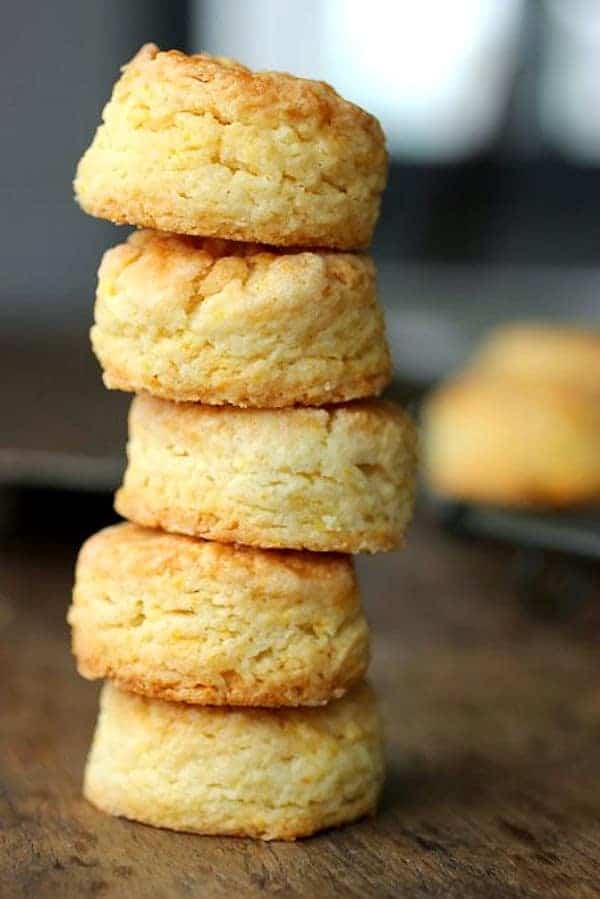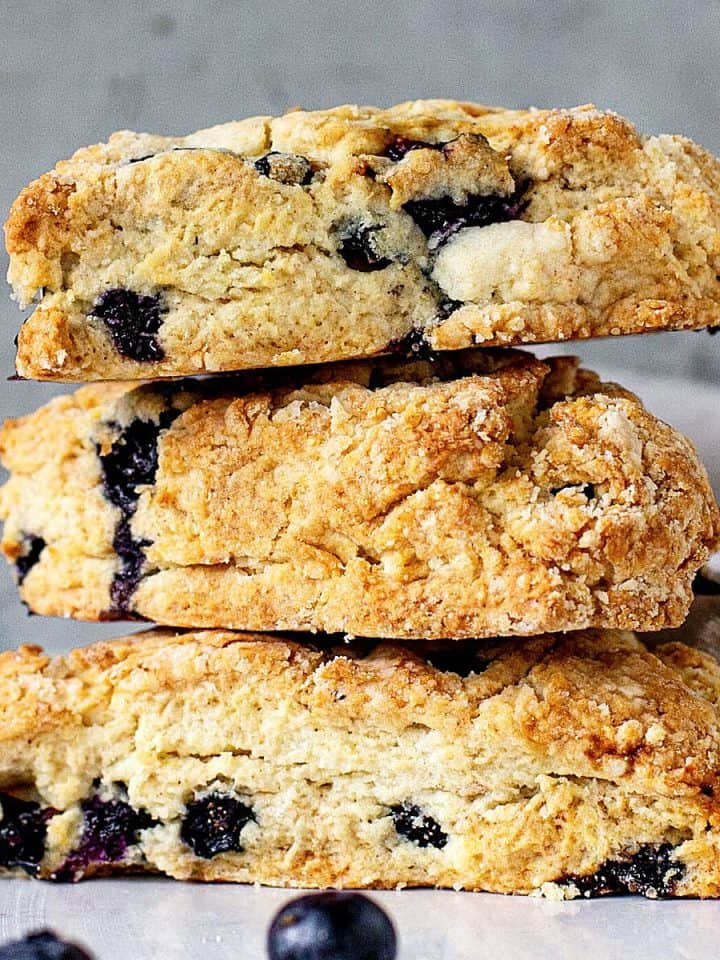Soft, tender, and buttery, these are the ultimate cream scones! Flavored with orange, you can have freshly baked scones in 45 minutes. They freeze beautifully too.

If you turn on the oven now, in an hour you can have the kitchen smelling amazing and these buttery, mildly sweet orange and cream mini scones standing beside your mug of tea – coffee for me, please.
They are by far my favorite recipe; no surprise since it's adapted from Nancy Silverton, one of my most admired bakers ever.
If there was a tea time tradition in my family (as explained in the post on strawberry buttermilk scones) it was to eat freshly baked scones, something that made me a scone fan, both for eating and making.

By hand
- Use a large bowl to mix the dry ingredients comfortably.
- Add the butter. It must be very cold and in small pieces to ensure a great result. This is important if you cut the butter into the flour by hand (as opposed to using a pastry cutter) because it will take several minutes and you don't want the butter to start warming up and melting. (You can buy pastry cutters online).
- Mix wet ingredients in another bowl before adding them to the butter mixture. Mix lightly with a fork until you have a shaggy mass and dump it on a lightly floured counter.
- Gather the dough into an irregular ball. This must be done with as few strokes as possible but the dough must be cohesive. It doesn't matter if there are dry spots here and there. This is not a smooth dough (image above).
In the food processor
The alternative to making the dough completely by hand is using the food processor (my favorite small appliance!) for the first part of the recipe.
- Put the flour and other dry ingredients in the bowl of the food processor. Pulse to mix.
- Scatter cold butter. Pulse a few times, just until the butter is the size of peas. It will be irregular. Don't overwork it.
- Add the wet ingredients (lightly mix them first in a bowl) and pulse a few times using on/off and barely start bringing it together. Don't process until you have a ball! You should have a shaggy mass.
- Finish on the counter, gathering the dough just enough so that you can cut the scones (images above).

Scones have very simple ingredients, but a few pointers should be followed if you want to achieve soft, tender ones, nicely risen.
Top tips
- Very cold ingredients. I’m not kidding when I say frozen butter, at least very cold. And don’t take the cream half an hour before you start mixing the scones. Butter, cream, and milk belong in the fridge until you need to scatter and pour them.
- Don't overwork the dough. It should come together but still have floury patches. You don’t need to work it until it’s smooth, like a pie dough for instance. It is an uneven dough, with dry spots, and that’s good for flakiness later.
- A rather high oven. They need that extra heat (and baking powder) to rise however they can in spite of all that butter and cream. And if by any chance you forgot to turn the oven on before you start with the mixing, please don’t leave the baking sheet with the cut scones waiting on the counter. Put them in the fridge or freezer for the ten or fifteen minutes it takes for the oven to reach its temperature.

Storing
One of the most wonderful things about scones is that they can be frozen raw, already formed. So you can make a big batch, cut them, put them on trays, and freeze them.
Once frozen, put them in a plastic bag or container so the tray doesn’t occupy freezer space.
That way, you can bake them to order! Directly from the freezer into a hot oven. Warm, freshly baked scones whenever you feel like it.
Related recipes you might like:
Let me know in the comments below if you made this recipe and loved it and if you had issues so we can troubleshoot together. I love to hear what you think, always. Thanks for being here. It's much appreciated.
You might also consider subscribing to our FREE Baking the Best email series and our regular newsletter. Or connect via Facebook, Instagram, and Pinterest.

Mini Cream Scones (different flavors)
Soft, tender and buttery, these are the ultimate cream scones! Flavored with orange, you can have freshly baked scones in 45 minutes.
- Total Time: 40 minutes
- Yield: About 25 mini scones
Ingredients
- 2 ¼ cups (315g) pastry flour or unbleached all-purpose flour
- ⅓ cup (65g) sugar, plus some extra for sprinkling before baking
- 1 tablespoon baking powder
- Pinch of salt
- Zest of 1 large orange
- 6 oz (180g) unsalted butter, cut into 1-inch cubes and frozen
- ¼ cup whole milk, very cold
- ½ cup cream, very cold, plus extra for brushing the tops of the scones
Instructions
- Preheat oven to 350ºF / 180ºC.
- Grease or line with parchment paper two baking sheets.
- In the bowl of a food processor, put flour, sugar, baking powder and salt. Process a few seconds just to mix.
- Scatter butter over this mixture and orange zest, and pulse a few times until the butter is the size of peas. (If making by hand use a large bowl and cut the butter with your hands or a pastry cutter. Then follow the recipe below).
- Transfer mixture to a large bowl.
- Pour milk and cream and quickly with a fork, mix everything until most of it is moist.
- Dump it onto the kitchen counter and quickly give it a few turns to avoid very dry spots. Some dry parts will remain and that is OK. The more you touch it and mix it, the tougher the baked scones will be.
- Pat the mixture about 2-inches high.
- With a round, small cookie cutter, cut scones (you might need to dip the cutter periodically in flour to aid with this) quickly and arrange them on the baking sheets.
- Brush tops with additional cream and sprinkle with sugar.
- Bake for about 20 minutes, until tops are golden and risen.
- Eat warm.
- Keep them on a tin, but even if eaten the next day, they are best briefly warmed in the oven.
Notes
- Very cold ingredients. I’m not kidding when I say frozen butter, at least very cold. And don’t take the cream half an hour before you start mixing the scones. Butter, cream, milk, they belong in the fridge until you need to scatter and pour them.
- Don't overwork the dough. It should come together but still have floury patches. You don’t need to work it until it’s smooth, like a pie dough for instance. It is an uneven dough, with dry spots, and that’s good for flakiness later.
- A rather high oven. They need that extra heat (and baking powder) to rise however they can in spite of all that butter and cream. And if by any chance you forgot to turn the oven on before you start with the mixing, please don’t leave the baking sheet with the cut scones waiting on the counter. Put them in the fridge or freezer the ten or fifteen minutes it takes for the oven to reach its temperature.
- Prep Time: 20
- Cook Time: 20
- Category: Scones & Biscuits
- Method: Baking
- Cuisine: International
Nutrition
- Serving Size: 1/25
- Calories: 116
- Sugar: 4.2 g
- Sodium: 9.4 mg
- Fat: 6.6 g
- Carbohydrates: 13.1 g
- Fiber: 0.3 g
- Protein: 1.4 g
- Cholesterol: 17.6 mg
Adapted from Pastries from the La Brea Bakery, by Nancy Silverton








Susan Grandelli says
Like this recipe very much. Would please specify what size cookie cutter. Thank you.
Paula Montenegro says
Hi Susan, I used a 1 and 1/4 inch round cutter.
C-J says
How long and at what temperature do you baked the frozen and uncooked scones? Do they go directly from the freezer to the oven?
Stepjanie Cull says
What kind of cream?like coffee cream?
Paula Montenegro says
Double or whipping cream.
Lauren Gaskill | Making Life Sweet says
My best friend is teaching in Argentina right now and I wish I could find the time (and money) to visit her there! I've heard nothing but lovely things! And lamb? Count me in! Love this recipe by the way. I can't have gluten but I would love to adapt these using an alternative flour. 🙂
laurasmess says
These are just stunning Paula. I love scones, believe it or not it's Aaron (my husband) who bakes the scones in our house! He uses lemonade... but I might just flip this recipe to him for next time! Love the idea of the cream with the fragrant orange. Yum. SO nice to read another recipe from you! Love xxx
milkandbun.com says
Beautiful-looking scones! and lovely photos as well! 🙂